![]()

Assets on The Balance Sheet
The assets on the balance sheet for computer sales and services company can be classified into the following categories:
1. Current assets:
These are assets that can be converted into cash or cash equivalents within one year. They include cash and cash equivalents, accounts receivable, inventory, and prepaid expenses.
2. Fixed assets:
These are assets that have a long useful life and are not intended for resale. They include land, buildings, equipment, and furniture.
3. Intangible assets:
These are assets that do not have a physical form but have value, such as patents, trademarks, and goodwill.
The specific assets that classified into each category will vary depending on the specific business.
For example, a computer sales and services company may have a large inventory of computers and computer parts, which would be classify as current assets.
They may also have a building and equipment that are use for their business, which would classify as fixed assets.
The assets of a computer sales and services company are typically list on the balance sheet in order of liquidity,
with the most liquid assets listed first. This means that the current assets listed first, followed by the fixed assets, and then the intangible assets.
Here is a more detailed breakdown of the different types of assets that may be found on the balance sheet of a computer sales and services company:
♦ Current assets:
1. Cash and cash equivalents:
This includes cash on hand, money market funds, and short-term investments that can be easily converted into cash.
2. Accounts receivable:
This is the amount of money owed to the company by its customers for goods or services that have been delivered or rendered.
3. Inventory:
This is the value of the goods that the company has on hand for sale.
4. Prepaid expenses:
This is the amount of money that the company has paid in advance for goods or services that have not yet been received.
♦ Fixed assets:
1. Land:
This is the land that the company owns.
2. Buildings:
This includes the buildings that the company owns or leases.
3. Equipment:
This includes the machinery, tools, and furniture that the company uses in its operations.
4. Furniture:
This includes the furniture that the company uses in its offices.
♦ Intangible assets:
1. Patents:
This gives the company the exclusive right to make, use, or sell a new invention.
2. Trademarks:
This gives the company the exclusive right to use a particular brand name or logo.
3. Goodwill:
This is the value of the company’s reputation and customer base.
The classification of assets on the balance sheet is important for several reasons. First, it helps investors and creditors to understand the financial health of the company. Second, it helps the company to track its assets and liabilities over time. Third, it helps the company to comply with accounting regulations.
To visit: https://www.mca.gov.in/
For further details access our website: https://vibrantfinserv.com